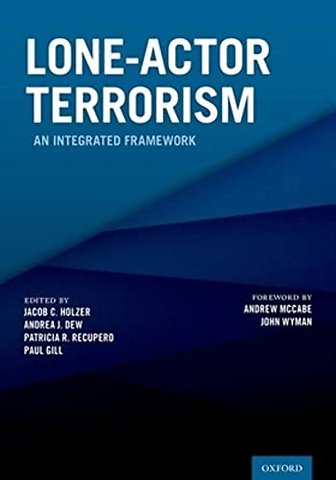Lone-Actor Terrorism
An Integrated Framework
Gebonden Engels 2022 1e druk 9780190929794Samenvatting
Lone-actor terrorism has unfortunately been on the rise in recent decades, causing major adverse societal effects in the United States and abroad. While lone-actor terrorists can be driven by a range of identifiable factors such as extremist views or availability of weapons, the process of becoming and identifying these individuals is deeply complicated.
Lone-Actor Terrorism: An Integrated Framework outlines the societal causes and impacts of lone-actor terrorism from a multi-disciplinary, international perspective. Drawing together seasoned insights across clinical and forensic mental health, sociology, criminology, law, military and intelligence, and security, this volume explores patterns common to lone-actor terrorists across four major sections: historical and case examples, clinical aspects, non-clinical professional and allied perspectives, and assessment and potential approaches to reducing the risk of lone-actor terrorism.
Contributors describe both individual clinical factors affecting lone-actors, including developmental aspects, mental health variables, psychoactive drugs, psychometrics and linguists, along with broader social factors such as propaganda and rhetoric, social media, and geographical considerations. This volume concludes with a review of the available threat and risk assessment tools applicable to lone-actor terrorism cases and provides guidance for professionals seeking to reduce risk.
While there is no uniform approach to the concept of lone-actor terrorism, this edited volume provides a diverse yet authoritative overview for those interested in better understanding the threats of lone-actor terrorism and its professional response.
Specificaties
Lezersrecensies
Inhoudsopgave
Preface
Foreword
Andrew McCabe and John Wyman
Introduction: Scope of the Problem, Definitions and Concepts
Jacob Holzer, Andrea J. Dew, Patricia R. Recupero, and Paul Gill
Chapter 1: Historical Aspects and Evolution of Lone-Actor Violence
Mark Hamm and Tammy Ayres
Chapter 2: Case Reviews in Lone-Actor Terrorism Incidents
Jacob Holzer, Olivia Zurek, and Lauren Simpson
Chapter 3: Clinical Psychiatric and Neuropsychiatric Aspects of Lone-Actor Terrorism
Robert P. Granacher, Jr., Danielle B. Kushner, and Jacob Holzer
Chapter 4: Psychoactive Agents and Mental Disorders in Lone-Actor Terrorism
Michael Arieli, Aviv Weinstein, Uri Ben Yaakov, Ronnie Berkovitz, Alina Poperno, Hagit Bonny-Noach, and Robert P. Granacher, Jr.
Chapter 5: Developmental Aspects of Lone-Actor Terrorists
Karl Mobbs, Gen Ignatius Tanaka, and Terry R. Bard
Chapter 6: The Role of Psychometrics in Investigating Lone-Actor Terrorism
Nancy P. Moczynski, Allen Schiller, Theodora Farah, and Eric Drogan
Chapter 7: Understanding Lone-Actor Violence through Linguistic Analysis
Isabelle W.J. van der Vegt, Bennett Kleinberg, and Paul Gill
Chapter 8: Propaganda and Lone-Actor Terrorism
Eric Drogan
Chapter 9: Lone-Actor Mass Casualty Events and Linkages to Organized Violent Salafist-Jihadist Inspired Terror Groups
Andrea J. Dew and Daniel Starr
Chapter 10: The Internet and Social Media as an Enabling Force
Patricia R. Recupero and Samara E. Rainey
Chapter 11: Geographic Context: Domestic vs. International Lone-Actors
Christopher Jasparro and Suzanne Levi-Sanchez
Chapter 12: Means, Mechanisms, and Trends of Operationalizing Violence
Christopher Winter, Ramón Spaaij, and Marilyn Price
Chapter 13: Role of Forensic Mental Health and Lone-Actor Violence
Ashley H. VanDercar, Ryan C. Wagoner, Phillip J. Resnick, Frank Farnham, and Emily Corner
Chapter 14: An Ethics Analysis of Lone-Actor Terror and Society's Response
Danielle B. Kushner and Philip J. Candilis
Chapter 15: Law Enforcement Response to Lone-Actor Incidents at the Local through Federal Levels
Douglas Brennan, Mark Concordia, and Michael Madden
Chapter 16: Post-9/11 U.S. Military and Intelligence Approaches to Lone-Actors
Corri Zoli
Chapter 17: U.S. Legal Perspectives: Legislative, Intelligence, and Law-Enforcement Aspects
Jeffrey H. Smith, Amy Jeffress, Christopher E. Beeler, and Tian Tian Xin
Chapter 18: Pursuing Lone-Actor Terrorists: U.K. Counterterrorism Law and Policy
Stuart Macdonald
Chapter 19: Lone-Actor Terrorism: Understanding Online Indoctrination
Steven Hassan, Jon Caven-Atack, Mansi J. Shah, and Simran Malhotra
Chapter 20: Hatred and Grievance as Constructs in Lone-Actor Terrorism
Jacob Holzer, Arya Shah, Eric Drogan, and Robert P. Granacher, Jr
Chapter 21: Comparing Lone-Actor Terrorism to Other High-Threat Groups
Jacob Holzer, Emily Threlkeld, William Costanza, Patricia R. Recupero, and Samara E. Rainey
Chapter 22: A Risk Analysis Framework of Lone-Actor Terrorism
Noémie Bouhana, Emily Corner, and Paul Gill
Chapter 23: A Framework for Preempting Lone-Actor Terrorists During the Pre-Incident Phases
Joshua Sinai
Chapter 24: Threat Assessment: the TRAP-18 and Application to a Lone-Actor Terrorism Incident
J. Reid Meloy and Jacob Holzer
Chapter 25: Use of Threat and Risk Assessment Tools in the Evaluation of Lone-Actor Terrorists
Hy Bloom, Reem Zaia, and Arya Shah
Chapter 26: Developing a Risk Assessment and Intervention Strategy: Future Directions in Research and Practice
Jacob Holzer, Andrea J. Dew, Patricia R. Recupero, and Paul Gill
Anderen die dit boek kochten, kochten ook
Rubrieken
- advisering
- algemeen management
- coaching en trainen
- communicatie en media
- economie
- financieel management
- inkoop en logistiek
- internet en social media
- it-management / ict
- juridisch
- leiderschap
- marketing
- mens en maatschappij
- non-profit
- ondernemen
- organisatiekunde
- personal finance
- personeelsmanagement
- persoonlijke effectiviteit
- projectmanagement
- psychologie
- reclame en verkoop
- strategisch management
- verandermanagement
- werk en loopbaan







